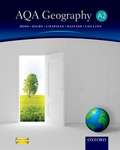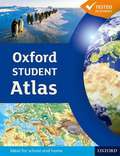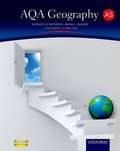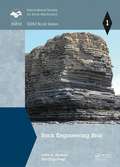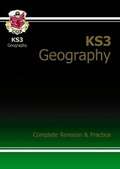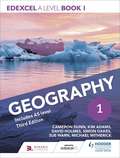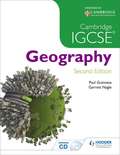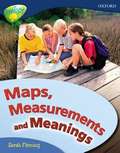- Table View
- List View
World maps of volcanoes and earthquakes (UEB uncontracted)
by RnibThese pages show a map of the World showing the Volcanoes and Earthquakes with an accompanying key. It is a multi-page image set on three pages. Page 1: Keys to world maps of volcanoes and earthquakes. This page has two keys: the one on the left is the key to the world map of volcanoes; the one on the right is the key to the world map of earthquakes. Both keys show two-letter abbreviations for the continents. Down from these are examples of the symbols and textures used. There is a locator dot shown, which will be at the top left of the page when the image is the right way up. Page 2: World map of volcanoes This is a map of the volcanoes on the surface of the earth framed by a dashed line image border. There is a locator dot shown, which will be at the top left of the page when the image is the right way up. All landmasses are textured and sea areas are untextured. On the left of the page are North and South America, in the centre Europe and Africa and to the right Asia and Australasia. Small volcanoes are marked by dots and large ones by small triangles. These are shown on Keys to world maps of volcanoes and earthquakes. Page 3: World map of earthquakes This is a map showing where earthquakes have occurred on the surface of the earth. It is framed by a dashed line image border. There is a locator dot shown, which will be at the top left of the page when the image is the right way up. All landmasses are textured and sea areas are untextured. On the left of the page are North and South America, in the centre Europe and Africa and to the right Asia and Australasia. Small earthquakes are marked by small dots and larger ones by larger dots. These are shown on Keys to world maps of volcanoes and earthquakes
World maps of volcanoes and earthquakes (large print)
by RnibThese pages show a map of the World showing the Volcanoes and Earthquakes with an accompanying key. It is a multi-page image set on three pages. Page 1: Keys to world maps of volcanoes and earthquakes. This page has two keys: the one on the left is the key to the world map of volcanoes; the one on the right is the key to the world map of earthquakes. Both keys show two-letter abbreviations for the continents. Down from these are examples of the symbols and textures used. There is a locator dot shown, which will be at the top left of the page when the image is the right way up. Page 2: World map of volcanoes This is a map of the volcanoes on the surface of the earth framed by a dashed line image border. There is a locator dot shown, which will be at the top left of the page when the image is the right way up. All landmasses are textured and sea areas are untextured. On the left of the page are North and South America, in the centre Europe and Africa and to the right Asia and Australasia. Small volcanoes are marked by dots and large ones by small triangles. These are shown on Keys to world maps of volcanoes and earthquakes. Page 3: World map of earthquakes This is a map showing where earthquakes have occurred on the surface of the earth. It is framed by a dashed line image border. There is a locator dot shown, which will be at the top left of the page when the image is the right way up. All landmasses are textured and sea areas are untextured. On the left of the page are North and South America, in the centre Europe and Africa and to the right Asia and Australasia. Small earthquakes are marked by small dots and larger ones by larger dots. These are shown on Keys to world maps of volcanoes and earthquakes
World maps of volcanoes and earthquakes (UEB contracted)
by RnibThese pages show a map of the World showing the Volcanoes and Earthquakes with an accompanying key. It is a multi-page image set on three pages. Page 1: Keys to world maps of volcanoes and earthquakes. This page has two keys: the one on the left is the key to the world map of volcanoes; the one on the right is the key to the world map of earthquakes. Both keys show two-letter abbreviations for the continents. Down from these are examples of the symbols and textures used. There is a locator dot shown, which will be at the top left of the page when the image is the right way up. Page 2: World map of volcanoes This is a map of the volcanoes on the surface of the earth framed by a dashed line image border. There is a locator dot shown, which will be at the top left of the page when the image is the right way up. All landmasses are textured and sea areas are untextured. On the left of the page are North and South America, in the centre Europe and Africa and to the right Asia and Australasia. Small volcanoes are marked by dots and large ones by small triangles. These are shown on Keys to world maps of volcanoes and earthquakes. Page 3: World map of earthquakes This is a map showing where earthquakes have occurred on the surface of the earth. It is framed by a dashed line image border. There is a locator dot shown, which will be at the top left of the page when the image is the right way up. All landmasses are textured and sea areas are untextured. On the left of the page are North and South America, in the centre Europe and Africa and to the right Asia and Australasia. Small earthquakes are marked by small dots and larger ones by larger dots. These are shown on Keys to world maps of volcanoes and earthquakes
Cone Volcano (tactile)
by RnibThis is a tactile diagram for GCSE level students. It shows the cross section of a cone volcano. Labels describe the shape and structure of the volcano, and students can feel the layers, and the lava rising up through the middle.
Composite Volcano (tactile)
by RnibThis is a tactile diagram for GCSE students. The diagram shows a cross section of a composite volcano, with different textures indicating ash and lava, showing how the volcano builds up.
Volcano types (UEB contracted)
by RnibThere are three types of volcano shown on this page. At the left is a composite volcano made up from alternating layers of rock and lava; at the top right is a shield volcano made from many layers of runny lava; and at the bottom right there is an ash volcano formed from lava and ash. Each diagram has a dashed line image border. At the bottom left of the page, stretching across the diagram, is a layer of molten magma (the mantle). In the middle of the diagram, the magma has forced its way through the Earth's crust and is erupting from the top of the volcano, and also through two smaller vents on either side. At the top right of the page is the much flatter form of a shield volcano with magma at the bottom of the diagram forcing its way through the Earth's crust. At the bottom right is an ash volcano. You can see the lava and ash forcing its way upward from the magma layer at the bottom of the page. There is a locator dot shown, which will be at the top left of the page when the image is the right way up.
Volcano types (UEB uncontracted)
by RnibThere are three types of volcano shown on this page. At the left is a composite volcano made up from alternating layers of rock and lava; at the top right is a shield volcano made from many layers of runny lava; and at the bottom right there is an ash volcano formed from lava and ash. Each diagram has a dashed line image border. At the bottom left of the page, stretching across the diagram, is a layer of molten magma (the mantle). In the middle of the diagram, the magma has forced its way through the Earth's crust and is erupting from the top of the volcano, and also through two smaller vents on either side. At the top right of the page is the much flatter form of a shield volcano with magma at the bottom of the diagram forcing its way through the Earth's crust. At the bottom right is an ash volcano. You can see the lava and ash forcing its way upward from the magma layer at the bottom of the page. There is a locator dot shown, which will be at the top left of the page when the image is the right way up.
Volcano types (large print)
by RnibThere are three types of volcano shown on this page. At the left is a composite volcano made up from alternating layers of rock and lava; at the top right is a shield volcano made from many layers of runny lava; and at the bottom right there is an ash volcano formed from lava and ash. Each diagram has a dashed line image border. At the bottom left of the page, stretching across the diagram, is a layer of molten magma (the mantle). In the middle of the diagram, the magma has forced its way through the Earth's crust and is erupting from the top of the volcano, and also through two smaller vents on either side. At the top right of the page is the much flatter form of a shield volcano with magma at the bottom of the diagram forcing its way through the Earth's crust. At the bottom right is an ash volcano. You can see the lava and ash forcing its way upward from the magma layer at the bottom of the page. There is a locator dot shown, which will be at the top left of the page when the image is the right way up.
World globe centred on Africa (UEB uncontracted)
by RnibThis is a globe map centred on the African continent. As the land masses shown are on the curved surface of the Earth, this image will be distorted, especially at its edge. There is a locator dot shown, which will be at the top left of the page when the image is the correct way up. Land is shown on the tactile image as a fine dotted texture and the sea by fine horizontal lines, these are green and blue respectively on the Large Print image. This globe map represents the Earth as seen from space, directly above the Africa. Central Africa is in the centre of the map, up the page is Europe and to the right of this, Asia. To the left of Africa are the Atlantic Ocean and the eastern half of South America, on the edge of the globe.
World globe centred on Africa (UEB contracted)
by RnibThis is a globe map centred on the African continent. As the land masses shown are on the curved surface of the Earth, this image will be distorted, especially at its edge. There is a locator dot shown, which will be at the top left of the page when the image is the correct way up. Land is shown on the tactile image as a fine dotted texture and the sea by fine horizontal lines, these are green and blue respectively on the Large Print image. This globe map represents the Earth as seen from space, directly above the Africa. Central Africa is in the centre of the map, up the page is Europe and to the right of this, Asia. To the left of Africa are the Atlantic Ocean and the eastern half of South America, on the edge of the globe.
World globe centred on Africa (UEB contracted)
by RnibThis is a globe map centred on the African continent. As the land masses shown are on the curved surface of the Earth, this image will be distorted, especially at its edge. There is a locator dot shown, which will be at the top left of the page when the image is the correct way up. Land is shown on the tactile image as a fine dotted texture and the sea by fine horizontal lines, these are green and blue respectively on the Large Print image. This globe map represents the Earth as seen from space, directly above the Africa. Central Africa is in the centre of the map, up the page is Europe and to the right of this, Asia. To the left of Africa are the Atlantic Ocean and the eastern half of South America, on the edge of the globe.
World globe centred on Africa (Large Print)
by RnibThis is a globe map centred on the African continent. As the land masses shown are on the curved surface of the Earth, this image will be distorted, especially at its edge. There is a locator dot shown, which will be at the top left of the page when the image is the correct way up. Land is shown on the tactile image as a fine dotted texture and the sea by fine horizontal lines, these are green and blue respectively on the Large Print image. This globe map represents the Earth as seen from space, directly above the Africa. Central Africa is in the centre of the map, up the page is Europe and to the right of this, Asia. To the left of Africa are the Atlantic Ocean and the eastern half of South America, on the edge of the globe.
AQA Geography A2 (PDF) (400MB+)
by Simon Ross Bob Digby Tim Bayliss Lawrence Collins Russell Chapman400MB+ File Request - email bookshare@rnib.org.uk to request this title by WeTransfer. This is a student-friendly and engaging resource for AQA GCE A2 specification. Written to match the demands of the specification, this student book motivates your students with accessible, interesting content and up-to-date case studies, while retaining exam-driven rigour.
Oxford Students Atlas (PDF) (400MB+)
by Patrick Wiegand400MB+ File Request - email bookshare@rnib.org.uk to request this title by WeTransfer. This new edition of the Oxford Student Atlas includes stunning satellite images, country data, and easy-to-read colourful mapping, presented in an accessible visual layout based on research into how students use maps. The atlas covers key exam specification themes and issues such as earthquakes and volcanoes, climate and climate change, economic activity, development, and globalisation. It includes comprehensive coverage of the British Isles, Europe, and the world. It is the ideal atlas for students to use on exam courses. The Oxford Student Atlas is accompanied by an e-Atlas CD-ROM providing an interactive version of the atlas suitable for both individual study and whole-class display.
Geog.2 (PDF) (400MB+)
by Rosemarie Gallagher Richard Parish400MB+ File Request - email bookshare@rnib.org.uk to request this title by WeTransfer. The students' book is revised and updated to deliver the revised Programme of Study for Key Stage 3 (from 2008). Contains direct, student-friendly language with illustrated step-by-step explanations.
AQA Geography AS (PDF)
by Simon Ross Bob Digby Russell Chapman Dan CowlingThis is a student-friendly and engaging resource for AQA GCE AS specification. Written to match the demands of the specification, this student book motivates your students with accessible, interesting content and up-to-date case studies, while retaining exam-driven rigour.
Shakespeare And The Geography Of Difference (PDF)
by John GilliesIn this engaging book, John Gillies explores Shakespeare's geographic imagination, and discovers an intimate relationship between Renaissance geography and theatre, arising from their shared dependence on the opposing impulses of taboo-laden closure and hubristic expansiveness. Dr Gillies shows that Shakespeare's images of the exotic, the 'barbarous, outlandish or strange', are grounded in concrete historical fact: to be marginalised was not just a matter of social status, but of belonging, quite literally, to the margins of contemporary maps. Through an examination of the icons and emblems of contemporary cartography, Dr Gillies challenges the map-makers' overt intentions, and the attitudes and assumptions that remained below the level of consciousness. His study of map and metaphor raises profound questions about the nature of a map, and of the connections between the semiology of a map and that of the theatre.9780521458535
Rock Engineering Risk (PDF)
by John A. Hudson Xia-Ting FengThis book provides a new, necessary and valuable approach to the consideration of risk in underground engineering projects constructed within rock masses. There are Chapters on uncertainty and risk, rock engineering systems, rock fractures and rock stress, the design of a repository for radioactive waste, plus two major case examples relating to the headrace tunnels and caverns for a hydroelectric project. These Chapters highlight in detail the authors' new rock engineering risk approach, especially how monitoring during construction can significantly reduce the construction risks. The book is particularly timely given the current increasing emphasis on geo-engineering safety, accountability and sustainability--which requires stricter attention to risk and greater reliability than ever before. Written by two eminent authors, the two most recent past-Presidents of the International Society for Rock Mechanics (ISRM), this modern and well-illustrated guide on Rock Engineering Risk complements the authors' previous 2011 book on Rock Engineering Design, also published by Taylor & Francis. The book will benefit engineers, contractors, clients, researchers, lecturers and advanced students who are concerned with rock engineering projects in civil, mining, geological and construction engineering worldwide.
OCR A Level Geography (PDF)
by Michael Raw David Barker Andy Palmer Peter Stiff Helen HarrisAn OCR endorsed textbook Help your students develop deep subject knowledge and high-level geographical skills with comprehensive coverage, stimulating activities and assessment support for all compulsory and optional topics; produced by the leading A Level Geography publisher and OCR's Publishing Partner for Geography. - Guides you and your students through the 2016 specification with clear explanations of the content and concepts, brought to life through examples and up-to-date case studies - Encourages students of all abilities to apply and improve their theoretical understanding through skills-focused activities based on a variety of textual, data and visual sources - Consolidates topic knowledge and aids self-assessment with review questions at the end of each chapter - Enables high-achieving students to target the top grades through suitably challenging extension material and activities - Teaches students how to approach assessments with confidence, providing opportunities to work through practice questions on every topic - Outlines relevant human and physical geography fieldwork projects throughout the text that meet the changed fieldwork assessment requirements
KS3 Geography Complete Study and Practice (PDF)
by Cgp BooksThis CGP Complete Study & Practice Book for KS3 Geography is fully up-to-date for the National Curriculum for 2014 and beyond. It covers every Physical Geography and Human Geography topic, and includes in-depth advice to help students develop their Geographical Enquiry skills. Each section contains clear, concise study notes and full-colour diagrams, plus a range of practice questions to test knowledge and understanding. (Answers to the questions are printed at the back.)
Edexcel A level Geography Book 1 (PDF)
by Cameron Dunn Kim Adams David Holmes Simon Oakes Michael Witherick Sue WarnThird / 3rd edition. Endorsed for Edexcel. Trust the leading A level Geography publisher to boost your students' geographical knowledge and skills with a fully updated edition of our bestselling Student's Book; designed to provide the in-depth subject coverage, developmental activities and exam support you need at a time of curriculum change. - Helps students acquire, apply and revise core knowledge using clear explanations of key geographical content and concepts - Progressively builds the geographical and data skills emphasised in the 2016 specification by offering plenty of opportunities to learn and practise relevant skills for each topic - Brings geographical theory to life with a bank of engaging, up-to-date case studies, examples and place contexts - Consolidates topic knowledge and enables students to track their learning with review questions at the end of each chapter - Prepares students for the demands of AS and A level examinations by including numerous exam-style questions, ideal for skills development and rolling revision throughout the course - Makes it easier for you to meet the increased fieldwork requirements, suggesting topic-focused enquiries for both physical and human geography
Geography (PDF)
by Paul Guinness Garrett NagleSecond / 2nd edition. Endorsed by Cambridge International Examinations Provide a key resource for your students with this revised edition for the updated 2016 syllabus (0460). This book has been carefully prepared to cover the full curriculum for the latest Cambridge International Examinations IGCSE Geography syllabus. It is accompanied by a CD-ROM offering study and revision support. - Covers the three geographical themes: population and settlement, the natural environment, and economic development - Up-to-date case studies from around the world ensure coverage of all the required case studies - Geographical skills and geographical investigations chapters provide ideal preparation for Papers 2 and 3
Oxford Reading Tree, Level 14, TreeTops Non-fiction: Maps Measurements and Meanings (PDF)
by Sarah FlemingBook band 13 grey. Oxford level 14. TreeTops Non-Fiction is an exciting extension to the Oxford Reading Tree TreeTops range. * How to Shock Your Parents - an exciting tour of youth culture and styles of fashion and music from Henry VIII through to modern day* Write Now! - an historical perspective of letters with hints and tips for writing different styles of letters, including text messages and email* The Moon - a detailed analysis of our cosmic neighbour and its importance to our planet and people* Maps, Measurements and Meanings - explores the purpose of numbers on maps, including their use in orienteering* The Power of Nature - a look at the amazing power of the wind, the sun and water and how we harness them for our use* Animals and Us - a discussion on how Man and animals have adapted to, and come to depend on, each other
OS map tactile introduction resources
by Markeaton SchoolTwo maps and some keys designed to intorduce OS maps and symbols to the tactile user. Line thicknesses and textures can be modified to suit individual needs.

